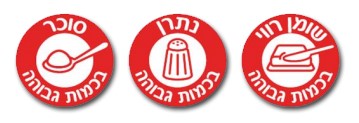What Israel’s Red & Green Food Labels Don’t Tell You About the Food You’re Buying

Natural salt is so important to health that salt licks are made available to animals. Giraffe and wildebeest enjoy this artificial salt lick at the Pilanesberg Game Reserve, South Africa [1]https://en.wikipedia.org/wiki/Mineral_lick#/media/File:Pilanesberg-Salt_lick-001.jpg.
How those red & green food labels misdirect attention
Like many governments around the world, the Israeli government attempts to steer the public’s health related decisions in particular directions, even though they may really be of more benefit to industry and not necessarily in the individual’s best interest. The red and green labeling on processed food products is one such example.
Beginning in January 2020, the Israeli Health Ministry required food manufacturers to put red or green labels on pre-packaged food items. To earn a green label, solid foods were not allowed to have more than 500mg of salt, 13.5g of total sugar, and 5g of total saturated fatty acids per 100 grams. Liquid foods were not allowed to have more than 400mg of sodium, 5g for total sugars, and 3g for total saturated fatty acids. Red labels mean that the products are considered to have high amounts of these ingredients, even if they’re naturally present.

These amounts were reduced beginning January 2021, to 400 mg sodium, 10 grams of sugar, and 4 grams of total saturated fatty acids per 100 grams of solid foods and to 300 grams of sodium, 5 grams of sugar, and 2 grams of saturated fatty acids per 100 ml.
Considering that
- we need more sodium and fatty acids in our diet to be healthy than what is “recommended”,
- sugar, even in low amounts, doesn’t belong in many products containing sugar,
- these are only three of many ingredients, and
- processing foods affects their nutritional value,
is it possible that there are important things that we are not being told?
Here’s what you should know
Food labels, in general, are very focused on just a few nutritional details that we have been trained to consider important above all else – calories, sugar, sodium, fat, cholesterol, and a few selected vitamins and minerals. Most foods contain many more important nutrients than the few listed. Real nutrient dense foods, which we should ideally be eating, contain many vitamins, minerals, enzymes, and micronutrients that are critical for our health. While some manufactured sugary, salty, and fatty products are really concerning, the bigger picture, that processed foods are often nutritionally depleted and some have been denatured, is not addressed. Many also contain chemicals and additives that may be worse for you than all the sugar, salt, and fat in the red label products. Perhaps the labels should be more reflective of all these damaged and damaging ingredients, as well.
Some suggestions for healthier (& more honest) labeling
These benefit the consumer, although manufacturers might not like them.
Red labels for:
- Sugars and artificial sweeteners:
- White sugar and anything that includes white sugar. Unlike unprocessed sugar, white sugar has been processed and stripped of the micronutrients needed to digest it. Your body will take those micronutrients from elsewhere in your body to do the job. Osteoporosis can be one of the long term effects!
- Food products for which there is no reason to add sugar, such as tomato products and canned fruits packed in light syrup rather than natural juices.
- Cakes, cookies, chocolates, and other items that list sugar as the first (or second) ingredient. Ingredients are listed in order of amount from most to least.
- Foods that have tremendous amounts of sugar – including sodas.
- Products that contain artificial sweeteners. Artificial sweeteners can cause serious metabolic derangement and other harms.
- Chemical additives:
- Products that have chemical additives and certain E-numbers that are detrimental to health.
Even the almonds given the green label in the above video may have lost some of their nutritional value – if they come from California where all almonds for commercial sale must be pasteurized in one of several ways. This is fine if you want to buy roasted or blanched almonds, but if you are expecting to buy totally raw almonds, you might want to check the country of origin beforehand.
- Grains:
- Cold breakfast cereals. Most cereals are made by pulverizing the grains into slurries (thin mixtures of a liquid and finely divided substances[2]https://www.thefreedictionary.com/slurries) and extruding the slurries under high pressure to make flakes and shapes. Most of the nutrients have been destroyed in the process, fatty acids are denatured, and lysine, a crucial amino acid is also destroyed. Although the manufacturing process is different, puffed cereals have similar problems[3]https://www.theguardian.com/business/2010/nov/23/food-book-extract-felicity-lawrence.
- Foods with altered grains labeled as whole grains.
- Fats:
- Foods with natural fats removed – Health risks associated with a low fat diet include hormone imbalances and insulin resistance resulting in diabetes, weight gain, gut problems, cognitive disorders, and more.
- Vegetable oils
- Polyunsaturated vegetable oils which create a harmful omega 6:3 imbalance.
- Canola and soy oils
- Oils thatare not cold pressed. They are extracted through a chemical process using dangerous solvents.
- Salt
- White table salt and any products using table salt. Like sugar, table salt is devoid of valuable micronutrients which have been processed out of them. Sodium regulates the concentration of water within and outside our cells and is used with potassium for nerve signaling; these micronutrients, which are found in natural sea salt (see below), are needed for salt to do its job properly. See here and here.
- Salt substitutes. Low sodium diets are dangerous.
- Dairy
- Milk in cartons that are not refrigerated as well as most refrigerated milk which, in Israel, is now ultra-pasteurized. “Because of the extreme process, ultra-pasteurized milk contains fewer nutrients than pasteurized milk, and even fewer when compared to raw milk. Researchers and microbiologists have also said that ultra-pasteurization is extremely harmful to milk, as it was found to flatten milk molecules and cause immune responses in the body when digested[4]https://foodfacts.mercola.com/pasteurized-milk.html.”
- Low-fat milk and dairy products (see Fats above).
Green labels for:
- Fats
- Foods that contain their full complement of healthy natural fats. Saturated (and other fats) found naturally in dairy, meat, and chicken, and other foods play important roles in the body. Dietary fat has protective benefits.
- Coconut products
- Yellow butter
- Organic foods
- Packaged organic foods without red label ingredients
- Naturally fermented foods. Fermenting foods boosts the food’s nutritional value and adds beneficial bacteria that improve digestion. Most supermarkets do not carry naturally fermented foods but these are a few you might find.
-
- Fermented soy foods – some miso, some soy sauce, tempeh, natto.
- Kombucha, a beverage sold in health food stores
- Sourdough breads.
-
- Milk
- Pasteurized milk, which is hard to find on the shelves in Israeli supermarkets today, is healthier than ultra-pasteurized milk (מפוסטר על). Tenuva 3% milk in bags still says מפוסטר and not מפוסטר על. Unfortunately, much of the organic milk is also ultra-pasteurized.
- Raw milk (where the farmers follow proper sanitary measures) is much healthier than pasteurized milk but is not legal to sell it in Israel and some countries. On the other hand, there are countries that have raw milk vending machines.
- Eggs, particularly free range and organic
- Fiber rich foods
- These are vegetables, fruits, nuts and unprocessed whole grains. Fiber is not digestible for humans, instead it helps improve digestion and detoxification, removing toxins and other waste products from our system.
If you would put labels on foods, how would you do it?
References
| ↑1 | https://en.wikipedia.org/wiki/Mineral_lick#/media/File:Pilanesberg-Salt_lick-001.jpg |
|---|---|
| ↑2 | https://www.thefreedictionary.com/slurries |
| ↑3 | https://www.theguardian.com/business/2010/nov/23/food-book-extract-felicity-lawrence |
| ↑4 | https://foodfacts.mercola.com/pasteurized-milk.html |